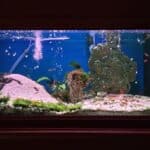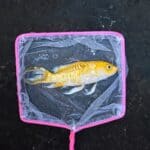Water quality is the most important element in any fish tank. It gets even more complicated for angelfish, which have saltwater and freshwater varieties. If the saline levels, pH balance, or ammonia content gets out of control, your angelfish may experience illness or stunted growth. In some instances, poor water quality can even lead to death.
Angelfish need their water changed at least once a month. Ideally, you will change it even more often, swapping out 10-20% percent of the water in small increments. You can do this once a week throughout the month. You should avoid changing 40% or more of the water in one sitting, and never change it all at once (unless it’s an emergency). Otherwise, your angelfish may experience shock and die.
Avoid changing the water every day, as this can stress out your angelfish. After you’re done, make sure the new water rebalances with the tank’s parameters. Angelfish are rather hardy, but a tank that’s too cold will cause illness, and water that’s too hard may discourage breeding. Fast-moving water should be avoided, and slightly acidic water should be encouraged.
Water Changes for Angelfish
Like all aquarium fish, angelfish need their water changed regularly. The schedule can look like this, depending on your tank:
- Once a month, if you have a powerful filter or very few fish
- Once every 2 weeks, changing about 30% at a time
- Once a week, changing 15-20% at a time
- Twice a week, changing 5-10% at a time.
The more often you change the water, the less that you’ll need to remove. Only changing 10% once a month will leave your aquarium dirty, allowing the waste and chemical imbalance to escalate. If you wait any longer, then you may need to change 50% or more. Sadly, that can be harmful to fish.
Unless there is a serious illness spreading through your tank, it’s unnecessary and dangerous to change all the water. Any sudden changes in temperature, chemical balance, and hardness can be a shock to the angelfish. Likewise, changing the water every day will disturb the aquarium and cause stress.
Change 15-20% of the water once a week. The change will be too subtle for your angelfish to notice. It will also accomplish 5 tasks:
Remove Waste
Changing the water helps to remove waste and all the byproducts of it. When leftover food is allowed to rot in the tank, or the fish naturally produce waste, your tank may become full of:
- Nitrites
- Ammonia
- Nitrates
When these chemicals are allowed to stack up, they can make the water toxic. Fish will eventually manifest signs of illness and lethargy. A water change helps to remove the excess and keep things in balance.
Prevent Unwelcome Growths
Without frequent water changes, your fish aren’t the only ones who will suffer. Other plants in your tank will eventually die off from the high acidity. Likewise, you may find bacteria and algae growing unchecked in your tank, damaging that closed ecosystem. Water changes help you to remove bacteria and give algae less to feed on.
Help Your Filter
Sadly, you can’t depend on a filter to eliminate all a fish tank’s impurities. Even quality filters are merely a way to slow down the waste build-up, so you don’t need to change the water every day. The filter will need to be cleaned regularly, and part of the water will need swapping out.
The same is true for aquariums that have plants or moss. Even if you carefully design the tank to be self-sufficient, periodic water changes are still necessary. Without the flow of currants to cycle old water into new, it will be difficult to maintain a healthy tank with no water changes.

What Water Do Angelfish Live In?
Angelfish are divided between freshwater and marine species. In the wild, they can be found in the Pacific Ocean’s coral reefs or the Amazon Basin’s tropical waters. The unique breeds have adapted to their environments and will always thrive in a tank that closely mirrors their original homes.
Freshwater
While both types of angelfish are kept as pets, freshwater angelfish are the most popular. They require the least amount of upkeep, without the delicate balance of saltwater conditions. In fact, most types of water found around your home are safe to add to your tank. From tap water to bottled water, it’s safe for your angelfish so long as you:
- Check the Hardness: Bottled water may be purified and have a lower pH, but it will usually have more minerals in it.
- Check for Chlorine: All water should be dechlorinated. This removes any bleaching or purifying chemicals from the water, which are harmless to people, but dangerous to fish.
- Avoid Distilled: Distilled water can speed up the growth of microorganisms and endanger the lives of your fish.
- Avoid Wild Water: In theory, it should be safe to take water from a stream, creek, river, or lake. However, there’s no way to confirm that it’s free of bacteria, which could harm your fish.
Saltwater
Saltwater angelfish will grow larger and healthier in environments that have the right amount of saline. In fact, even adding salt to their diet can significantly improve their growth rate, according to the Journal of Applied Aquaculture.
As such, if you want to keep a saltwater angelfish, then you need to consider all the above factors, but also:
- Salt: You will need to create saline water for your angelfish to live in. You should avoid using table salt, and instead search out aquarium salt. The ideal amount is 1 gallon of water to 1 cup of salt.
- Hardness: Saltwater angelfish need harder water than freshwater varieties. You can accommodate this by adding the calcium and magnesium that angelfish would find in the ocean. You can sprinkle in crushed seashells or use bottled treatments found in pet stores.
How Many Gallons of Water Do Angelfish Need?
An angelfish tank should be at least 20 gallons in size. However, this will only suit one angelfish with a limited amount of decorations. Keep in mind that this is only humane for smaller angelfish, like the dwarf breed, that only reach 4 inches in size. Any larger breeds will be cramped and begin to manifest health issues.
For larger angelfish, 55 gallons or more is ideal. For every fish that you add, you should include another 20 gallons. When the fish are young and still growing, a smaller tank will be fine. Just make sure to scale it up as your angelfish matures, otherwise you’ll stunt its growth.
Depending on the species, angelfish can reach up to 12 inches in length. The bigger the tank, the more likely they are to reach their full size and enjoy a healthy life.
With that in mind, tall tanks are preferred. Angelfish gain most of their size vertically, with a long dorsal and graceful fins trailing along beneath them. They tend to explore all levels of the tank, so the more room they have to swim, the better.
Water Parameters For Angelfish
The water parameters for your angelfish will depend on their species. Large, saltwater varieties will have different needs from small, freshwater kinds. With that said, most angelfish exists somewhere in this range. Be sure to check your exact species of angelfish and make adjustments accordingly:
- pH: 6.8 to 7.8
- Hardness: 3 to 8 dKH
- Temperature: Between 78 and 84 degrees F.
- GPH: 150 to 200
If you’re creating a reef aquarium for your angelfish, then the parameters become a little more complicated. You will need to customize the settings to your exact species. However, these figures work as a general estimate:
- Gravity: 1.023 to 1.025
- Alkalinity: 8 to 12 dKH
- Nitrate: < 1.0 ppm
- Phosphate: < 0.2 ppm
- Calcium: 350 – 450 ppm
- Magnesium: 1250 – 1350 ppm
- Iodine: 0.06 – 0.10 ppm
- Strontium: 8 – 14 ppm
Do Angelfish Need Warm Water?
Angelfish will thrive best in warm water. They’re native to tropical regions worldwide, making their homes in sunny ocean reefs and warm rivers. Because of that, the ideal water temperature for an angelfish is 75 to 82 degrees Fahrenheit. Depending on the species, they may like it warmer, at around 78 and 84 degrees Fahrenheit.
Do Angelfish Like Hard Water?
Many cichlid species love hard water, but angelfish are not one of them. These fish aren’t particularly fond of water that’s rich in minerals. Healthy, adult angelfish can tolerate it, and saltwater angelfish will like harder water than freshwater species. However, the ideal range for angelfish is 54 to 145 ppm.
If your tank falls outside of this range, it won’t be immediately harmful to your angelfish. Some aquarium owners purposefully adjust this range to accommodate other fish species in the tank. However, this must be done carefully.
Sudden changes may shock your angelfish or cause them to develop illnesses. If done gradually, hard water could still make your angelfish less likely to breed. Likewise, angelfish fry tend to thrive better in softer water, according to the International Journal of Research in Fisheries and Aquaculture
How To Soften Angelfish Water
If the water in your angelfish tank is too hard, there are ways to adjust it. Use these techniques to make the habitat more ideal to your angelfish:
Water Pillows
You can install water softening pillows into your tank’s filter. This works to absorb excess minerals out of the water and then distribute the purified water back into the tank. Water pillows will be good for 3-4 full cycles before they need to be replaced.
Reverse Osmosis
Reverse osmosis units are often sold in hardware stores, and you can install one into your kitchen sink. This will remove minerals, heavy metals, and even pollutants from your tap water. That water can then be treated with a conditioner and added to your tank.
Use Peat
For a more natural solution, you can soften water with the use of peat. Place some in your filter and allow the water to flow over it. This will leech out excess minerals and make the hard water more palatable for your angelfish. Just keep in mind that 2-3 weeks may be necessary to see results.
Do Angelfish Like Fast-Moving Water?
Angelfish do not like fast-moving water. In fact, they will struggle in fast currents that are made by powerful filters. Your fish may exhaust themselves at the least, and become injured at the worst.
Angelfish prefer slow-moving rivers and streams in the deep waters of the Amazon basin. In the Pacific, they stay near coral reefs where they can leisurely explore, hunt, and maintain their territory. Most angelfish will prefer to hover in place, even refusing to swim if they encounter rough water.
As such, be sure to keep your angelfish tank docile. Avoid powerful filters or any machines that produce a heavy current. Angelfish will still need the water aerated and full of oxygen, of course. That makes air stones or bubblers an ideal solution, making the water oxygen-rich without disturbing your angelfish.
What Temperature Water for Angelfish?
Angelfish prefer water that’s between 78 to 84 degrees Fahrenheit. Certain breeds of saltwater angelfish may prefer slightly colder temperatures, at around 72 degrees.
However, it’s always better to go high instead of low. Angelfish are from tropical regions and will immediately show a health decline if they’re too cold. Even if they show no signs of illness, their overall lifespan may be shortened in low temperatures.
Most angelfish owners buy a heater for this purpose. This can work to:
- Bring the tank up to the right temperature
- Maintain it, even when your home gets hotter or colder
- Acclimate new water to the correct ranges in a short amount of time
If you are breeding angelfish, then slightly cooler temperatures are preferred. Angelfish breed most successfully in the mid-70s range. In this case, it’s best to separate the breeding pair and their eggs from the community tank. Once the eggs have begun to hatch, you can gradually raise the temperature back to the low-80s. 84 degrees will help the eggs to grow, hatch, and thrive.

Water pH for Angelfish
The pH level is a measure of how acidic or alkaline-heavy the water is. If you want your angelfish to thrive, then you need to get the pH balance perfect. You can use a home testing kit to determine your tank’s pH level and to monitor it.
When changing water, give the tank one full day before you test the pH level. The sudden introduction of new water will upset the balance. About 24 hours will give it time to settle, so you can get an accurate reading. The perfect balance for angelfish will be:
- 8.1 to 8.4 for most saltwater angelfish
- 6.8 to 7.8 for most freshwater angelfish
This is slightly acidic, but still within a low range. According to the Journal of Fish Biology, angelfish do not thrive in very acidic water, but do share habitats that are nearby more acidic waters. The small cross-over has given angelfish a taste for mildly high pH levels.
Of course, you need to check your exact species of angelfish and then confirm the exact range. Each will have its own preferences. If you plan to increase the pH, then you can add crushed seashells or chemical buffers to adjust the range. If you want to lower the pH, you can place driftwood inside the tank or use a different chemical buffer.
Angelfish Died After Water Change
If you’ve changed the water and your angelfish die, then you’ve made a mistake. It happens to every fish owner at least once, but luckily, it can be avoided in the future. Be sure to double-check your process and see where it went wrong. You may have:
- Changed out too much water, such as 40% or more at once
- Added distilled, chlorinated, or wild water that introduced a harmful chemical or type of bacteria to the tank
- Added water that was too hot or too cold
- Added water that had a starkly different pH balance
- Added water that was extremely hard, or heavy in minerals
- Forgotten to filter or condition the water before adding it
- Stirred up sediment while changing the water, jarring the fish, or mixing a heavy dose of ammonia into the water
The most common reason for fish dying after a water change is shock. A sudden and massive change in the water leads to an immediate shift in the metabolism of the fish. If the angelfish cannot quickly adapt, their systems collapse and they die.
Even those who can tolerate it may end up dying later from exhaustion or other diseases. It may even have a shorter lifespan overall, unable to reach the average for its species. To keep this from happening, always be sure to:
- Double-check the water you’re adding
- Try to keep the water as identical to the original water as possible, in pH, hardness, and temperature.
- Always treat it with a water conditioner to balance the levels and avoid bacteria.
- Make incremental water changes, ideally once or twice a week.
- Avoid changing more than 30% of the water at once, ideally changing only 10%.
- If your fish are sick or weak, change 3-5% of the water every other day.
All in all, it’s best to change the water in your angelfish tank no less than once a month. If you do it more frequently, then you’ll have greater control over the environment in your tank. This can help you provide the most balanced, healthy, and happy aquarium for your angels.








